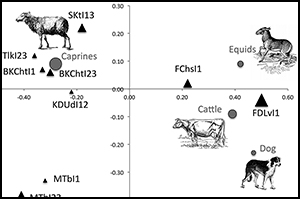Crossref Citations
This article has been cited by the following publications. This list is generated based on data provided by
Crossref.
Scarre, Chris
2017.
EDITORIAL.
Antiquity,
Vol. 91,
Issue. 360,
p.
1413.
Ullah, Isaac I.T.
Chang, Claudia
and
Tourtellotte, Perry
2019.
Water, dust, and agro-pastoralism: Modeling socio-ecological co-evolution of landscapes, farming, and human society in southeast Kazakhstan during the mid to late Holocene.
Journal of Anthropological Archaeology,
Vol. 55,
Issue. ,
p.
101067.
BLESA CUENCA, JOSÉ LUIS
2020.
Die Landwirtschaft der arischen Völker aus der frühen Eisenzeit: Tiere und Menschen im vorachämenidischen Mittelasien1.
Archaeofauna,
Vol. 29,
Issue. ,
p.
119.
Li, Yue
Zhang, Chengrui
Wang, Zhen
Dou, Haifeng
Liu, Huan
Hou, Furen
Ma, Mingzhi
Qian, Yaopeng
and
Chen, Honghai
2020.
Animal use in the late second millennium BCE in northern China: Evidence from Zaoshugounao and Zaolinhetan in the Jing River valley.
International Journal of Osteoarchaeology,
Vol. 30,
Issue. 3,
p.
318.
Kumar, Vikas
Bennett, E Andrew
Zhao, Dongyue
Liang, Yun
Tang, Yunpeng
Ren, Meng
Dai, Qinyan
Feng, Xiaotian
Cao, Peng
Yang, Ruowei
Liu, Feng
Ping, Wanjing
Zhang, Ming
Ding, Manyu
Yang, Melinda A
Amridin, Berdimurodov
Muttalib, Hasanov
Wang, Jianxin
Fu, Qiaomei
and
Ávila-Arcos, Maria C
2021.
Genetic Continuity of Bronze Age Ancestry with Increased Steppe-Related Ancestry in Late Iron Age Uzbekistan.
Molecular Biology and Evolution,
Vol. 38,
Issue. 11,
p.
4908.
Rouse, Lynne M.
Doumani Dupuy, Paula N.
and
Baker Brite, Elizabeth
2022.
The Agro-pastoralism debate in Central Eurasia: Arguments in favor of a nuanced perspective on socio-economy in archaeological context.
Journal of Anthropological Archaeology,
Vol. 67,
Issue. ,
p.
101438.
Rouse, Lynne M.
Woldekiros, Helina S.
and
Cerasetti, Barbara
2022.
Faunal remains from Ojakly, a Late Bronze Age mobile pastoralist campsite in the Murghab region, Turkmenistan.
Journal of Archaeological Science: Reports,
Vol. 44,
Issue. ,
p.
103531.
Portero, Rodrigo
Ariño, Enrique
Elorza, Mikelo
Gurt, Josep M.
Martínez Ferreras, Verónica
and
Pidaev, Shakir R.
2022.
Zooarchaeology of ancient Termez (Uzbekistan): From the Greco-Bactrian period to Islamic times.
Archaeological Research in Asia,
Vol. 31,
Issue. ,
p.
100384.
Plasteeva, N. A.
Kosintsev, P. A.
Shagirbaev, M. S.
Devjashin, M. M.
and
Gasilin, V. V.
2023.
HOLOCENE DISTRIBUTION OF THE ASIATIC WILD ASS (<i>EQUUS HEMIONUS</i>, EQUIDAE, PERISSODACTYLA) IN KAZAKHSTAN.
Зоологический журнал,
Vol. 102,
Issue. 10,
p.
1189.
Festa, Marcella
Dou, Haifeng
Monteith, Francesca
Orton, David
Wang, Qianwen
Zong, Tianyu
Liu, Bin
and
Li, Yue
2023.
Faunal exploitation during the Proto-Zhou period in the Jing River Valley: Evidence from Sunjia and Xitou.
Frontiers in Earth Science,
Vol. 10,
Issue. ,
Ariño, Enrique
Uribe, Paula
Angás, Jorge
Piqué, Raquel
Portero, Rodrigo
Martínez-Ferreras, Verónica
and
Gurt, Josep M.
2023.
Adaptive Dynamics of Settlement Models in the Urban Landscape of Termez (Uzbekistan) from c. 300 BCE to c. 1400 CE.
Land,
Vol. 12,
Issue. 8,
p.
1550.
Rhoné-Quer, Camille
2023.
Les (inter)dépendances nomades/sédentaires des marges iraniennes et centrasiatiques de l’empire islamique au xe siècle : l’exemple des produits de l’élevage.
Les Nouvelles de l'archéologie,
p.
51.
Khounani, Alireza
2024.
The Vineyards of Parthian Arsacid Nisa (151–15 BCE): Rent Farming and Cash Crop Agriculture from the Perspective of the Ostraca.
ISIMU,
Vol. 26,
Issue. ,
p.
109.
Rouse, Lynne M.
Haruda, Ashleigh
Hunter, Sydney A.
and
Kroll, Sonja
2025.
Meta‐analysis of an integrated archaeobiological and environmental dataset: Revealing hidden trends in Chalcolithic and Bronze Age socio‐economies in southern Central Asia.
Archaeometry,
Vol. 67,
Issue. 2,
p.
457.



